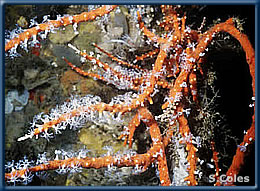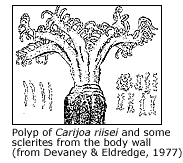

Phyllorhiza punctata

Cassiopea andromeda

Pennaria disticha

Carijoa riisei

Diadumene lineata
Carijoa riisei
 Snowflake
coral
Snowflake
coral
Phylum Cnidaria
Class Anthozoa
Subclass Octocorallia
Order Telestacea
Family Clavulariidae
Description
The species forms erect, branching colonies with flexible stems. Each
tall axial polyp has many short lateral polyps. Polyps, when extended,
have eight white frilly tentacles, like the rays of a snowflake. The long
stems or branches of the octocoral are a dirty white color, but they are
almost always covered with a very thinly encrusting orange-red sponge,
yet to be identified. Two types of sclerites occur in the body wall.
Habitat
 Most
commonly found in the fouling community of harbors, usually on pier pilings
or wrecks which are not exposed to direct sunlight. It is found outside
of harbors, especially along the leeward coast of Oahu, on shipwrecks
or in sheltered and shaded crevices or shallow caves on the deeper reefs.
Most
commonly found in the fouling community of harbors, usually on pier pilings
or wrecks which are not exposed to direct sunlight. It is found outside
of harbors, especially along the leeward coast of Oahu, on shipwrecks
or in sheltered and shaded crevices or shallow caves on the deeper reefs.
Distribution
Hawaiian Islands
Throughout the main Islands
Native Range
Western Atlantic, from Florida to Brazil
Present Distribution
Western Atlantic, Hawaiian Islands, possibly now widespread in the Indo-Pacific
(see Remarks)
Mechanism of Introduction
Unintentional, most likely as fouling on ships' hull
Impact
Fouling organism. Ecological impact unstudied, but probably some competition
for space with other invertebrates.
Ecology
Feeding
Like all cnidarians, C. riisei has tiny stinging
cells in their tentacles which enable the capture of motile zooplankton.
Reproduction
Polyps may reproduce asexually by simply splitting in two, or sexually
by release and fertilization of gametes into the water column. The resulting
planula larvae settle to the bottom and develop directly into young polyps.
Remarks
This orange soft coral or "snowflake coral" native to the western
Atlantic Ocean from Florida to Brazil, was first found in 1972 in the
fouling community in Pearl Harbor (Thomas, 1979, as Telesto riisei). Muzik
(pers. comm.) noted that a species of Carijoa
is now also known from Chuuk, Palau, the Philippines, "Indonesia",
Australia, and Thailand: whether some of these also represent the species
riisei is not known, although it could certainly have achieved such a
wide distribution in more than 20 years of ship-mediated dispersal if
it were first introduced to the Hawaiian Islands in the late 1960s or
early 1970s. Colin and Arneson (1995) published photographs of Carijoa
sp. from Chuuk, in Micronesia, and from a cement ship in Enewetak, Marshall
Islands, noting that "it is a very common fouling organism found
on buoys, wharves and ship bottoms, plus turbid water reefs."
References
Colin, P.L. and L.Arneson. 1995. Tropical Marine Invertebrates. Coral
Reef Press, Beverly Hills. 296 pp.
Thomas, W.J. 1979. Aspects of the micro-community associated with Telesto
riisei, an introduced alcyonarian species. MS Thesis, Zoology Dept., University
of Hawaii.
© 2002 Hawaii Biological Survey, Bishop Museum
contact